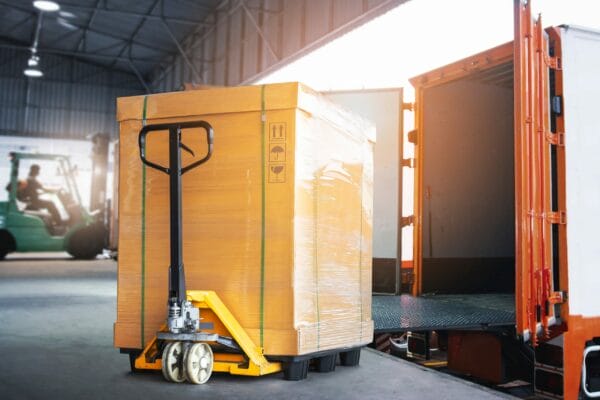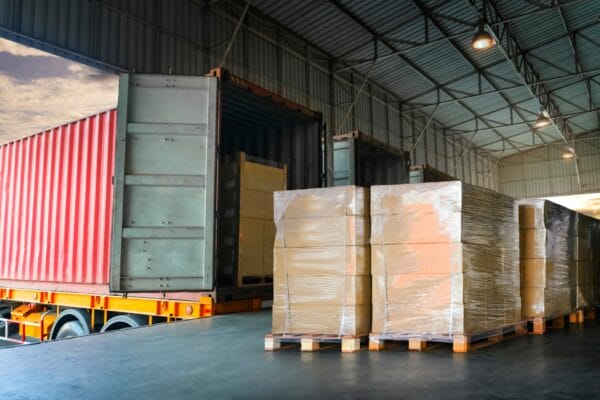Palletizing goods is a common practice in the logistics industry. In this article, we consider the benefits and downsides of palletized shipping and examine how best to prepare a load for safe transportation.
What Is Palletized Shipping?
Palletized shipping involves using pallets to tender goods for shipment. Pallets provide stability, protect the goods loaded onto them, and make it easier to move with mechanical handling equipment.
For example, shelf-stable foods and beverages are sold to supermarkets in bulk quantities, and those boxes are palletized before shipping. When the pallet arrives at its destination, warehouse staff can break it down and stock their stores’ shelves with individual units.
What Are the Benefits of Palletized vs. Non-Palletized Shipping?
Palletizing shipments has a lot of benefits, such as:
- Quick and easy loading and unloading: Pallets can be moved quickly using a forklift or a pallet jack.
- Improved labor efficiency: Rather than moving multiple boxes of goods individually for loading and unloading, everything can be stacked on a pallet and moved at once. This efficiency cuts labor requirements, saving money in the long term.
- Protects goods from damage: In addition to using the NMFC’s proper minimum packaging requirements, which significantly mitigates the chance of damage, products can be wrapped with plastic film to secure the items to the pallet, providing stability while goods are in transit, stopping shipments from being tampered with, or having items from falling off the pallet, which could lead to missing pieces of freight.
- Reduced risk of staff injury: When warehouse staff employees move non-palletized goods, they're at risk of repetitive strain injuries or could be injured from falling/poorly secured products. Palletizing shipments reduces these risks.
What Are the Disadvantages of Palletized vs. Non-Palletized Shipping?
While palletizing shipments makes sense for most products, it's not always the best option. Consider the disadvantages:
- Not all goods suit standard pallets: While standard wooden pallets are suitable for transporting most goods, some shipments require specialty pallets, which can be challenging to source and expensive to purchase.
- The up-front cost of purchasing pallets: In the long term, palletizing shipments can save money, but the up-front cost of buying pallets can be a deterrent for businesses that don't ship a high volume of goods.
- Pallets take up space in a container: Conversely, companies that ship a lot of products may find that the extra space the pallets take up (and their weight) adds to their shipping and holding expenses. It's a small difference, but it can mount up if margins are thin.
What Are the Dimensions of a Shipping Pallet?
Shipping pallets come in different sizes and styles. The Grocery Manufacturers Association recommends a standard pallet of 48" x 40", with a maximum weight limit of 4,600 pounds. However, not everyone adheres to this standard. Other standards include:
- Eur 1 (European Standard): 31.5" x 47.24"
- ISO (GMA-Style): 40" x 48"
- Australian ISO: 45.9" x 45.9"
- Asian ISO: 43.4" x 43.4"
- North American ISO: 42" x 42"
Some freight companies permit bigger pallets, but they class them as oversized pallets. If you're unsure whether the shipping company you're using accepts your pallet size, contact them to confirm their restrictions.
How to Prepare a Pallet for Shipping
Choosing the right pallet and configuring it correctly is essential if you plan on palletizing a load. Consider the following when preparing a palletized load:
Pallet Types
There are three main types of pallets to choose from:
- GMA style: Popular in the grocery industry and an ISO standard, adopting this standard has made the distribution process much smoother, as manufacturers, distributors, and retailers can expect goods to be palletized in a standard format.
- Reversible pallets: The top and bottom deck of reversible pallets have the same structure, so they can be flipped, making it easier for forklifts to load and unload them without worrying about arranging the pallets.
- Winged pallets: This style of pallet has a deck board hanging over the stringers to strengthen it, allowing it to accept a heavier load.
Load Types
Consider the product you're putting on the pallets carefully. For best results, place the heaviest items on the bottom of the pallet and stack them in vertical, staggered columns. Lay the containers flat and ensure they don't hang over the edges of the pallet.
Keep fragile items in the center. If you're packing anything sharp or with large, protruding edges, use packing forms or packaging materials before putting them on the pallet to protect them from damage.
Spacing
Ideally, you should bind the products together tightly to ensure maximum stability. If gaps or spaces exist between products on the pallet, the load might shift, increasing the risk of the load toppling over when the wrapping is removed.
Try to fit as many items as possible on the pallet while reducing the gap between products. This helps protect the products from damage and saves you money on total shipping fees.
Securing the Load
After consulting the NMFC’s minimum packaging requirements, and once the pallet is loaded, goods can be secured to it using stretch wrap. Wrap the film to the bottom of the pallet and run the wrap tightly around the load so it covers the products and holds them in place. Aim to perform three wraps at the top and three at the bottom, ensuring sufficient overlap in the middle to cover the load fully.
If you have a tall load, use corner protectors to help prevent damage to the top of the pallet and help the load stay properly balanced. You may also use additional straps to hold the load in place. Although unitizing a pallet load with plastic film provides stability and can increase efficiency, it is always important to use the minimum packaging requirements set forth in the NMFC, as plastic film alone does not afford adequate protection.
Additional Palletizing Tips
Properly securing the load is vital when transporting large, heavy, or bulky pallets. Consider these tips to ensure a smooth, efficient shipping process and protect the well-being of the people handling your loads:
- Make sure goods are stacked evenly: Aim to stack goods evenly, with a balanced surface area. Take a little extra time when you first assemble a shipment to develop an efficient and safe way of stacking that prevents hassle and saves money in the long run.
- Label everything before shipping: Verify every item on the pallet is properly labeled and appears on the manifest. Small mistakes can create costly delays.
Palletizing High-Volume Shipments
If you ship many of the same products over time, you can quickly become familiar with how best to prepare and secure the loads to a pallet. Over time, pallets' speed, efficiency, and health and safety benefits can mount up.
If you follow the best practices listed above, palletization can quickly become an important part of your shipping and handling routine.



